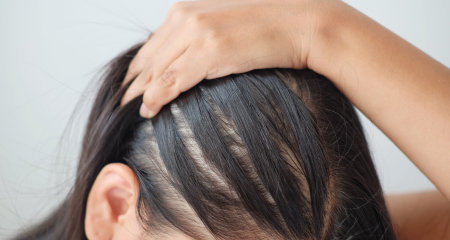
Experiencing sudden hair thinning patches, or witnessing your eyelashes vanish can be unsettling. If you or your loved one is grappling with unanticipated hair loss, it might be a case of alopecia. The adept dermatologists at Northstar Dermatology in Southlake, Texas, ensure a precise diagnosis of alopecia and construct a comprehensive treatment strategy. This aims to foster hair regrowth or mitigate additional loss. If alopecia is a concern, connect with experienced professionals. Arrange your consultation via call or through online scheduling.
Alopecia is the medical term for any form of hair loss. While many people associate “alopecia” specifically with alopecia areata—a type of patchy hair loss caused by the immune system attacking hair follicles—the term actually encompasses all types of hair loss, including hereditary hair loss and other causes beyond alopecia areata.
Alopecia, or hair loss, can be categorized into two main types: scarring and non-scarring hair loss.
Scarring hair loss is less common and typically results from an immune reaction targeting the hair follicles. This can cause symptoms like redness, scaling, itching, or burning of the scalp, ultimately leading to follicle damage, scar formation, and permanent hair loss.
Non-scarring hair loss is more common and includes types such as telogen effluvium and androgenetic (hereditary) hair loss. Telogen effluvium is a widespread shedding often triggered by a significant physiological stressor, like a severe infection, chronic illness, surgery, major weight loss, or childbirth. This type of hair loss usually begins about three months after the triggering event and lasts around six months, with a favorable outlook for full regrowth.
Hereditary, or androgenetic hair loss, is widespread, influenced by both genetics and sensitivity to androgen hormones. It affects up to 80% of people at some point, although the age of onset, rate, and extent of hair loss vary among individuals.
Before starting treatment for any type of hair loss, it’s essential to consult with your physician. A physical exam and lab tests may be necessary to rule out any underlying medical causes.
For hereditary hair loss, multiple treatment options are available. Minoxidil 5% foam or liquid, commonly known as Rogaine, is an effective over-the-counter option that can be applied to the scalp once or twice daily. Visible results may take up to six months, and some initial shedding can occur. Higher minoxidil concentrations are available by prescription, and oral minoxidil is also an emerging option. Minoxidil can help thicken existing fine hairs, leading to a fuller appearance.
Several oral medications are also proven to treat hair loss. Spironolactone, used for female pattern hair loss, reduces androgen levels. Finasteride and dutasteride work for both men and women by blocking androgen effects on hair follicles. Other treatments like tofacitinib, Olumiant (baricitinib), and Litfulo (ritlecitinib) have shown promise for severe alopecia areata. Each medication has its own potential side effects, which should be discussed with your doctor.
Corticosteroid injections in thinning or balding areas can also encourage regrowth, usually requiring repeat treatments every 4–8 weeks.
Hair loss can be a sensitive issue, and many companies market costly, ineffective products targeting these insecurities. While there’s no instant cure or way to completely restore youthful hair, current treatments offer real solutions. As research advances, more effective options continue to emerge. Always seek qualified medical advice to make informed decisions confidently and safely.